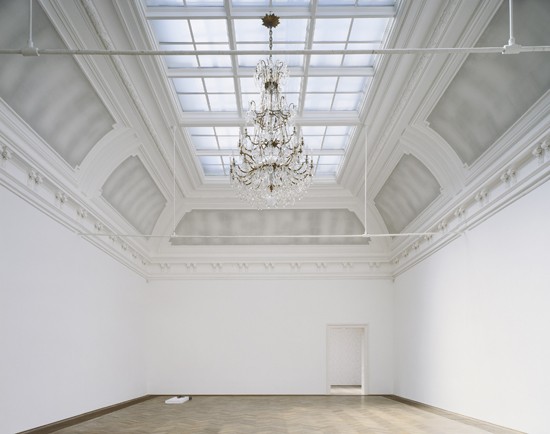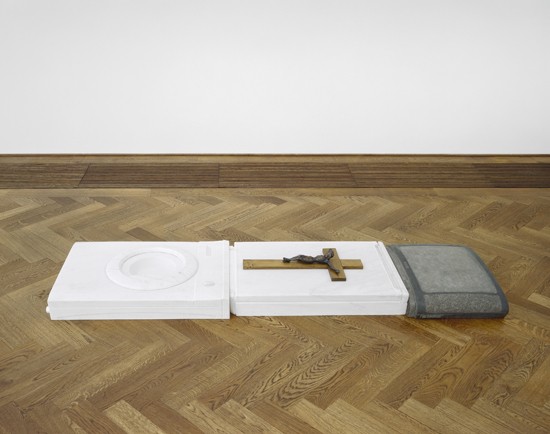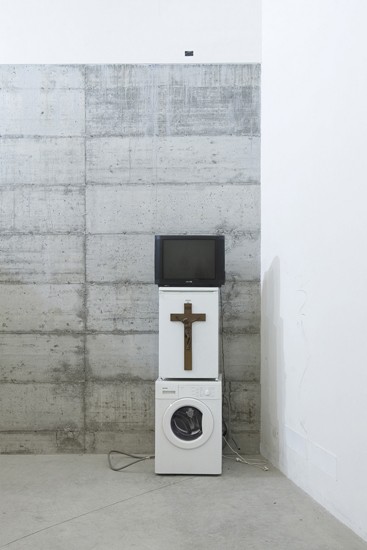 Installation view of the solo exhibition “Where the Lions Are” at Kunsthalle Basel, 2009; foreground: 08:03:51, 28.05.2009 (2009), late 19th-century chandelier from the ballroom of the former Hotel Majestic, Avenue Klèber, Paris. Photo Serge Hasenböhler. All images: Unless otherwise stated, courtesy Danh Vo and Galerie Isabella Bortolozzi, Berlin.
Installation view of the solo exhibition “Where the Lions Are” at Kunsthalle Basel, 2009; foreground: 08:03:51, 28.05.2009 (2009), late 19th-century chandelier from the ballroom of the former Hotel Majestic, Avenue Klèber, Paris. Photo Serge Hasenböhler. All images: Unless otherwise stated, courtesy Danh Vo and Galerie Isabella Bortolozzi, Berlin.(Perversion)
ART iT: When people describe your work as performative, do you find that relates in anyway to the idea that it’s unfolding in the moment?
DV: I guess. I don’t see any reason why we should lock ourselves into categories. I like things to be fluid. Sometimes you do an exhibition so you put something in a space, sometimes you make an interview, and sometimes you just do your research. I like this idea of just doing things. I don’t plan too much.
ART iT: Do you ever feel that your reception in Europe is based on your identity, and does that play into the performance of your works?
DV: I would be naïve to say no. It’s something I’m aware of and use when necessary. I’m not against it. I try to see the opportunities in the way things run. Sometimes you stick out, sometimes you blend in.
We are not the Salvation Army. You can imagine the problems I have with communication: someone says, “We have to explain this and that,” and my response is, “No, we are not here to provide the information that’s been lacking; we are not supposed to compensate for running around and bombing other countries.” That is a really fucked up idea.
ART iT: The establishment wants artists to create anti-war works so it can feel better about bombing?
DV: Better about history. There was a really involved discussion when a big American institution wanted to buy the chandelier piece. There are three chandeliers. The one that first interested me – from the newspaper in 1973 – was hanging over the center of the table, but there were also two peripheral chandeliers. I split them up so they are three separate works, all titled based on the time they were dismantled. The titling was related to the idea that the works represent this moment that points forwards and backwards and is also in the present as well.
At first the institution was interested in having the big chandelier, but I objected. What does it mean that the big institution should have this “essential” piece? I felt that would have been like a reconsolidation of history, and the work shouldn’t act in that way. After discussions with the curators, we agreed that it’s much more perverted to place the peripheral chandeliers in the big institution. Instead of acting as a reconsolidation, it creates more tension and meaning. Art is easily used to compensate for history, and I want to oppose that situation. I think we should be more perverted.
 Tombstone for Nguyen Thi Ty (2009), marble, granite, bronze and wood relief; installation view from the solo exhibition “Where the Lions Are” at Kunsthalle Basel, 2009. Photo Serge Hasenböhler.
Tombstone for Nguyen Thi Ty (2009), marble, granite, bronze and wood relief; installation view from the solo exhibition “Where the Lions Are” at Kunsthalle Basel, 2009. Photo Serge Hasenböhler.ART iT: Is this perversion apparent in all your works? In the case of your grandmother’s tombstone, for example, is their room to be perverted?
DV: Yes. I think the tombstone is quite perverted. But of course I don’t make works to be perverted only. I want them to function on multiple layers. When I make a tombstone of someone who was meaningful not only to me but also to the rest of my family, it only adds to the quality that this has a personal function and meaning.
I first asked my mother to design the tombstone. I thought she should do it because it’s her mother, although I was guiding her. I told her that a tombstone should be something that illustrates the important things in one’s life. She came up with the idea of reproducing this carrying device common in Asia, the stick with two baskets hanging off the sides. Apparently all her life my grandmother sold stuff at market like this. But there was a practical problem – I didn’t know how to make such a thing, should we bronze cast it or what? I thought it was a bit too wild or strange.
I realized I had to come up with my own ideas because my mother’s were just too crazy. The final tombstone comes from a sculpture I made using all the things my grandmother received when she arrived in Germany, for which I stacked everything together in the exhibition space. I decided to make a copy of these items that had so much meaning for my grandmother: the washing machine, fridge, the television and the crucifix. I simply reproduced the whole front of the pre-existing sculpture.
My family loved it. They said, “Poor woman, that really was what she wanted.” She ended up as this total proletarian in Hamburg.
ART iT: Do you think about Duchamp at all?
DV: People refer to him, but I don’t know his work well enough to relate to it.
ART iT: You’re already beyond the readymade when you use these objects?
DV: When I made the tombstone I was thinking, now it’s time for me to make something myself, but then I just copied one of my own works. Things just happen. A method I use is to work against myself. With the tombstone I wanted to produce something instead of using readymades, to find out what the differences are at least. It is important for me to push back and forth and to not frame myself. There’s no reason to do that.
Kunsthalle Basel was a good illustration of the way that I construct exhibitions, because I don’t think in big scales, I think of one object after the other. I started with the chandelier but wanted something else in the space and it became the tombstone. Then I thought it was too dialectic, and knowing about the history of the missionaries in Indochina, I added them as a way to break up that dialectic relationship with the Vietnam War. I wanted to bring in this element showing how the Vietnamese themselves were chasing all these missionaries, that power relations are this complex, back-and-forth system.
And I wanted to see the tension between dragging the chandeliers into a museum and then making an object in the museum and dragging it out to a cemetery, and see what this would mean and how it would function. It was an examination of how things live, I guess.
 Oma Totem (2009), objects from the artist’s grandmother Nguyen Thi Ty:
Oma Totem (2009), objects from the artist’s grandmother Nguyen Thi Ty: 26″ Phillips television set, Gorenje washing machine, Bomann refrigerator,
wooden crucifix, and personal entrance card for a casino, appliances
received from The Immigrant Relief Programme and the crucifix from the
Catholic Church upon her arrival in Germany in 1980, 220 x 60 x 60 cm.
Installation view from the exhibition “Last Fuck,” Galleria Zero, Milan, 2009.
ART iT: Would it be simplistic to say, then, that Basel was a statement against imperialism or about the effects of imperialism?
DV: I think the missionaries were so good because they confuse things. This is also one reason why I started to work with the indigenous people in the Vietnamese highlands, because they are always being chased by the Vietnamese. There are all these levels of suppression. If the French never occupied Vietnam, then Cambodia wouldn’t exist. The Vietnamese were totally imperialistic themselves. There are all these things one should be aware of. It’s a continuous cycle of suppression – we like it.
Danh Vo: A Five-Part Dossier on How Things Live
